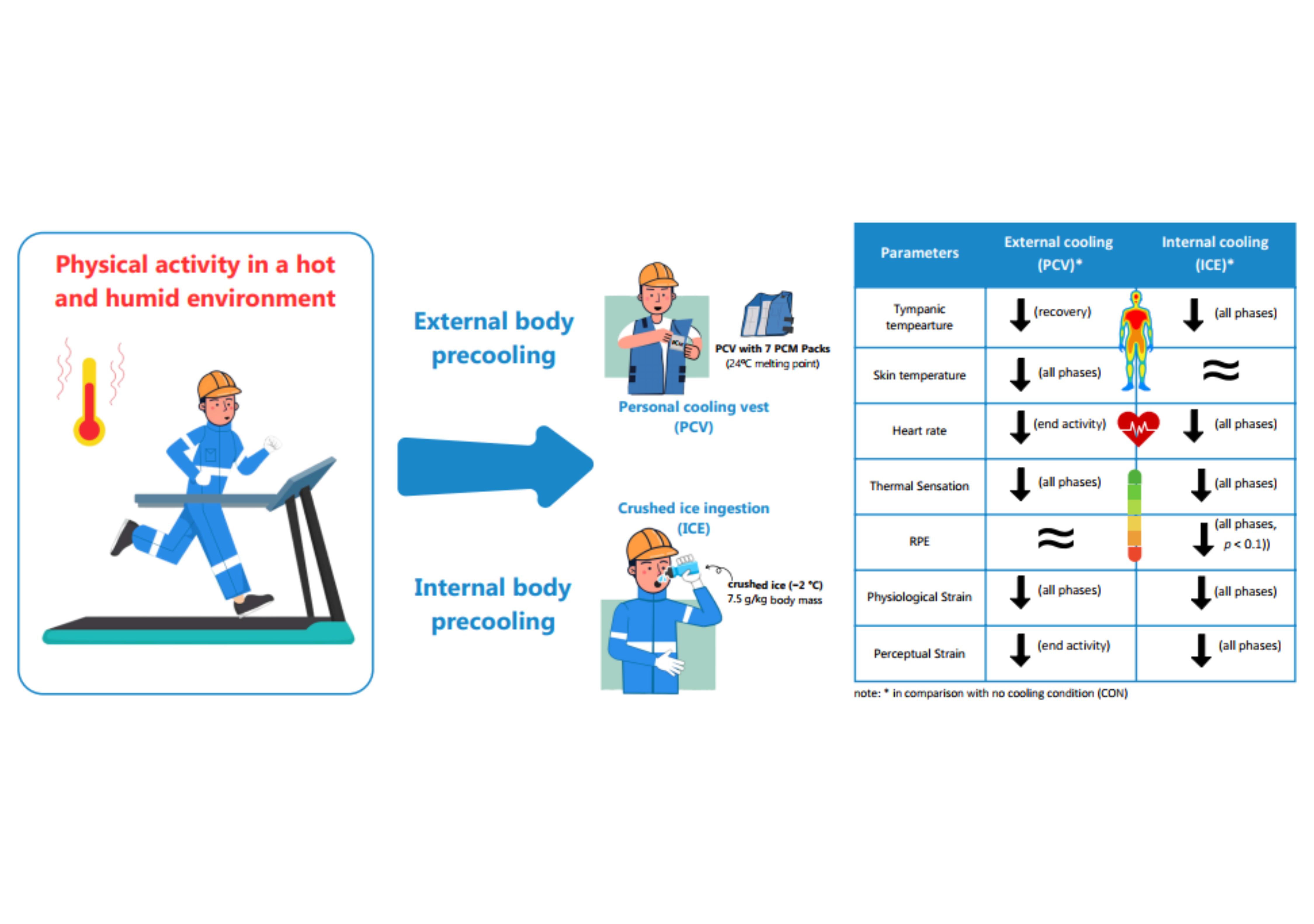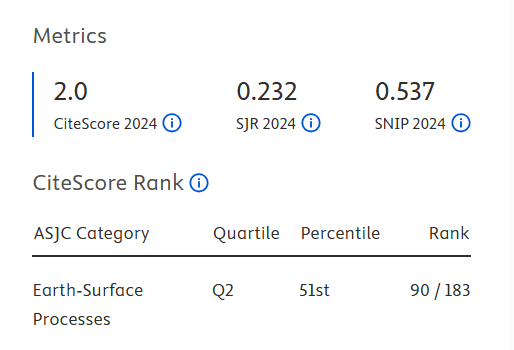Practical Precooling Methods for Alleviating Heat Strain during Occupational Heat Exposure

Downloads
Working in hot and humid environments poses significant challenges to thermoregulation and potentially affects performance and health. Strategies for mitigating heat stress are critical for workers exposed to high thermal loads. This study investigated practical cooling strategies, that is, phase-change vest (PCV) cooling and crushed ice (ICE) ingestion, before a physical activity in a hot and humid environment to alleviate heat strain. Two experiments were conducted to evaluate the efficacy of the cooling methods: the first experiment involved participants wearing a PCV for precooling, and the second experiment involved participants consuming an ICE (7.5 g/kg body mass) before exercising under the same conditions. Physiological responses including tympanic temperature, skin temperature, and heart rate, along with perceptual measures such as thermal sensation and perceived exertion, were assessed. The results showed that both the PCV and ICE interventions effectively reduced heat strain, although they had different effects. PCV cooling effectively reduces physiological and perceptual strains immediately after physical exertion; however, this effect does not last in the recovery phase. In contrast, ICE ingestion reliably lessens physiological and perceptual strains throughout the activity and recovery periods, substantially impacting both physical strain and the perception of effort. These findings highlight the significance of ICE ingestion as an effective strategy for enhancing worker health and safety in demanding thermal environments.
Acharya, P., Boggess, B., & Zhang, K. (2018). Assessing heat stress and health among construction workers in a changing climate: A review. International Journal of Environmental Research and Public Health, 15(2), 247.
Cai, W., Ng, B., Wang, G., Santoso, A., Wu, L., & Yang, K. (2022). Increased ENSO sea surface temperature variability under four IPCC emission scenarios. Nature Climate Change, 12(3), 228-231.
Choo, H. C., Choo, D. H. W., Tan, I., Chang, J., Chow, K. M., Lee, J. K. W., Burns, S. F., & Ihsan, M. (2023). Effect of ice slurry ingestion on thermoregulatory responses during fixed-intensity cycling in humid and dry heat. European Journal of Applied Physiology, 123(10), 2225–2237.
Choo, H. C., Nosaka, K., Peiffer, J. J., Ihsan, M., & Abbiss, C. R. (2018). Ergogenic effects of precooling with cold water immersion and ice ingestion: A meta-analysis. European Journal of Sport Science, 18(2), 170–181.
Flouris, A. D., Dinas, P. C., Ioannou, L. G., Nybo, L., Havenith, G., Kenny, G. P., & Kjellstrom, T. (2018). Workers’ health and productivity under occupational heat strain: a systematic review and meta-analysis. The Lancet Planetary Health, 2(12), e521–e531.
Gao, C., Kuklane, K., & Holmér, I. (2010). Cooling vests with phase change material packs: the effects of temperature gradient, mass and covering area. Ergonomics, 53(5), 716–723.
Gao, C., Kuklane, K., & Holmér, I. (2011). Cooling vests with phase change materials: the effects of melting temperature on heat strain alleviation in an extremely hot environment. European Journal of Applied Physiology, 111(6), 1207–1216.
Guo, Y., Li, S., Liu, D. L., Chen, D., Williams, G., & Tong, S. (2016). Projecting future temperature-related mortality in three largest Australian cities. Environmental Pollution, 208, 66–73.
House, J. R., Lunt, H. C., Taylor, R., Milligan, G., Lyons, J. A., & House, C. M. (2013). The impact of a phase-change cooling vest on heat strain and the effect of different cooling pack melting temperatures. European Journal of Applied Physiology, 113(5),1223–1231.
Itani, M., Ouahrani, D., Ghaddar, N., Ghali, K., & Chakroun, W. (2016). The effect of PCM placement on torso cooling vest for an active human in hot environment. Building and Environment, 107, 29–42.
Iwata, R., Kawamura, T., Hosokawa, Y., Chang, L., Suzuki, K., & Muraoka, I. (2021). Comparison of the effect of post-exercise cooling with ice slurry ingestion between males and females. Journal of Thermal Biology, 99, 102979.
Kay, D., Taaffe, D. R., & Marino, F. E. (1999). Whole-body pre-cooling and heat storage during self-paced cycling performance in warm humid conditions. Journal of Sports Sciences, 17(12), 937-944.
Moran, D. S., Shitzer, A., & Pandolf, K. B. (1998). A physiological strain index to evaluate heat stress. American Journal of Physiology-Regulatory, Integrative and Comparative Physiology, 275(1), R129–R134.
Onitsuka, S., Zheng, X., & Hasegawa, H. (2015). Ice slurry ingestion reduces both core and facial skin temperatures in a warm environment. Journal of Thermal Biology, 51, 105–109.
Onitsuka, S., Zheng, X., & Hasegawa, H. (2020). Ice slurry ingestion before and during exercise inhibit the increase in core and deep-forehead temperatures in the second half of the exercise in a hot environment. Journal of Thermal Biology, 94, 102760.
Pogačar, T., Casanueva, A., Kozjek, K., Ciuha, U., Mekjavić, I. B., Kajfež Bogataj, L., & Črepinšek, Z. (2018). The effect of hot days on occupational heat stress in the manufacturing industry: implications for workers’ well-being and productivity. International Journal of Biometeorology, 62, 1251-1264.
Quod, M. J., Martin, D. T., Laursen, P. B., Gardner, A. S., Halson, S. L., Marino, F. E., Tate, M. P., Mainwaring, D. E., Gore, C. J., & Hahn, A. G. (2008). Practical precooling: Effect on cycling time trial performance in warm conditions. Journal of Sports Sciences, 26(14), 1477–1487.
Reinertsen, R. E., Farevik, H., Holbo, K., Nesbakken, R., Reian, J., Royset, A., & Thi, M. S. L. (2008). Optimizing the performance of phase change material in personal protective clothing systems. Int J Occup Saf Ergon, 14, 43–53.
Rezaei-Hachesu, V., Naderyan Fe'li, S., Hokmabadi, R., Kazemi, M., & Golbabaei, F. (2022). Impact of Heat Stress on Renal Function: A Systematic Literature Review Focusing on Workplace Heat. Journal of Occupational Health and Epidemiology, 11(2), 157-170.
Ross, M., Abbiss, C., Laursen, P., Martin, D., & Burke, L. (2013). Precooling Methods and Their Effects on Athletic Performance. Sports Medicine, 43(3), 207–225.
Seng, M., Ye, M., Choy, K., & Ho, S. F. (2018). Heat stress in rice vermicelli manufacturing factories. International Journal of Occupational and Environmental Health, 24(3–4).
Sheng, R., Li, C., Wang, Q., Yang, L., Bao, J., Wang, K., ... & Huang, C. (2018). Does hot weather affect work-related injury? A case-crossover study in Guangzhou, China. International Journal of Hygiene and Environmental Health, 221(3), 423-428.
Shirish, A., Kapadia, V., Kumar, S., Kumar, S., Mishra, S., & Singh, G. (2016). Effectiveness of a cooling jacket with reference to physiological responses in iron foundry workers. International Journal of Occupational Safety and Ergonomics, 22(4), 487–493.
Siegel, R., & Laursen, P. B. (2012). Keeping your cool: Possible mechanisms for enhanced exercise performance in the heat with internal cooling methods. Sports Medicine, 42(2), 89–98.
Siegel, R., Maté, J., Brearley, M. B., Watson, G., Nosaka, K., & Laursen, P. B. (2010). Ice slurry ingestion increases core temperature capacity and running time in the heat. Medicine and Science in Sports and Exercise, 42(4), 717–725.
Siegel, R., Maté, J., Watson, G., Nosaka, K., & Laursen, P. B. (2012). Pre-cooling with ice slurry ingestion leads to similar run times to exhaustion in the heat as cold water immersion. Journal of Sports Sciences, 30(2), 155–165.
Sylla, M. B., Faye, A., Giorgi, F., Diedhiou, A., & Kunstmann, H. (2018). Projected heat stress under 1.5 C and 2 C global warming scenarios creates unprecedented discomfort for humans in West Africa. Earth's Future, 6(7), 1029-1044.
Takeshima, K., Onitsuka, S., Xinyan, Z., & Hasegawa, H. (2017). Effect of the timing of ice slurry ingestion for precooling on endurance exercise capacity in a warm environment. Journal of Thermal Biology, 65(August 2016), 26–31.
Tikuisis, P., Mclellan, T. M., & Selkirk, G. (2002). Perceptual versus physiological heat strain during exercise-heat stress. Medicine & Science in Sports & Exercise, 34(9), 1454-1461.
Tokizawa, K., Sawada, S., Oka, T., Yasuda, A., Tai, T., Ida, H., & Nakayama, K. (2014). Fan-precooling effect on heat strain while wearing protective clothing. International Journal of Biometeorology, 58(9), 1919–1925.
Tyler, C. J., Sunderland, C., & Cheung, S. S. (2015). The effect of cooling prior to and during exercise on exercise performance and capacity in the heat: a meta-analysis. British Journal of Sports Medicine, 49(1), 7–13.
Watkins, E. R., Hayes, M., Watt, P., & Richardson, A. J. (2018). Practical pre-cooling methods for occupational heat exposure. Applied Ergonomics, 70, 26–33.
Wijayanto, T., Bratadewi, V. K., Rahman, G. F. A., Sinawang, M., & Prakasa, H. S. (2019). Comparison of the Effect of Cold Fluid and Crushed Ice Ingestion on Thermoregulatory Responses during Physical Activity in a Simulated Hot-Humid Environment. Industrial Engineering & Management Systems, 18(4), 600–608.
Wijayanto, T., Herliansyah, M. K., Ayu, A. S., & Sudarman, P. A. (2021). Can edible oils, as practical phase change materials, be used for body cooling after physical work in a hot–humid environment? Human Factors and Ergonomics in Manufacturing & Service Industries, 31(6), 613–624.
Wittbrodt, M. T., Sawka, M. N., Mizelle, J. C., Wheaton, L. A., & Millard‐Stafford, M. L. (2018). Exercise‐heat stress with and without water replacement alters brain structures and impairs visuomotor performance. Physiological Reports, 6(16), e13805.
Yeo, Z. W., Fan, P. W. P., Nio, A. Q. X., Byrne, C., & Lee, J. K. W. (2012). Ice slurry on outdoor running performance in heat. International Journal of Sports Medicine, 33(11), 859–866.
Yi, W., & Chan, A. P. (2017). Effects of heat stress on construction labor productivity in Hong Kong: a case study of rebar workers. International Journal of Environmental Research and Public Health, 14(9), 1055.
Copyright (c) 2025 Journal of Engineering and Technological Sciences

This work is licensed under a Creative Commons Attribution-NonCommercial-NoDerivatives 4.0 International License.












